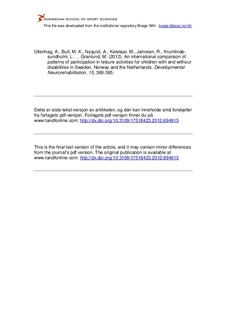| dc.contributor.author | Ullenhag, Anna | |
| dc.contributor.author | Bult, Maureen K. | |
| dc.contributor.author | Nyquist, Astrid | |
| dc.contributor.author | Ketelaar, Marjolijn | |
| dc.contributor.author | Jahnsen, Reidun | |
| dc.contributor.author | Krumlinde-Sundholm, Lena | |
| dc.contributor.author | Almquist, Lena | |
| dc.contributor.author | Granlund, Mats | |
| dc.date.accessioned | 2014-03-19T09:16:31Z | |
| dc.date.available | 2014-03-19T09:16:31Z | |
| dc.date.issued | 2012-10 | |
| dc.identifier.citation | Developmental Neurorehabilitation. 2012, 15, 369-385 | nb_NO |
| dc.identifier.uri | http://hdl.handle.net/11250/192638 | |
| dc.description | I Brage finner du siste tekst-versjon av artikkelen, og den kan inneholde ubetydelige forskjeller fra forlagets pdf-versjon. Forlagets pdf-versjon finner du på http://dx.doi.org/10.3109/17518423.2012.694915 / In Brage you'll find the final text version of the article, and it may contain insignificant differences from the journal's pdf version. The original publication is available at http://dx.doi.org/10.3109/17518423.2012.694915 | nb_NO |
| dc.description.abstract | Purpose: To investigate whether there are differences in participation in leisure activities between children with and without disabilities in Sweden, Norway and the Netherlands and how much personal and environmental factors explain leisure performance.
Methods: In a cross-sectional analytic design, the Children's Assessment of Participation and Enjoyment, CAPE, was performed with 278 children with disabilities and 599 children without disabilities aged 6–17 years. A one-way between-groups ANOVA explored the differences in participation between the countries. Hierarchical multiple regression analysis assessed if age, gender, educational level, living area and country of residence explained the variance in participation.
Results: Scandinavian children with disabilities participated in more activities with higher frequency compared to Dutch children. The strongest predictor was country of residence. For children without disabilities, differences existed in informal activities, the strongest predictor was gender.
Conclusion: Differences in school- and support systems between the countries seem to influence patterns of participation, affecting children with disabilities most. | nb_NO |
| dc.language.iso | eng | nb_NO |
| dc.publisher | InformaHealthcare | nb_NO |
| dc.subject | VDP::Medisinske Fag: 700::Klinisk medisinske fag: 750::Pediatri: 760 | nb_NO |
| dc.subject | VDP::Medisinske Fag: 700::Klinisk medisinske fag: 750::Fysikalsk medisin og rehabilitering: 764 | nb_NO |
| dc.subject | participation | nb_NO |
| dc.subject | recreation | nb_NO |
| dc.subject | children | nb_NO |
| dc.subject | adolescents | nb_NO |
| dc.subject | disabilities | nb_NO |
| dc.subject | European comparison | nb_NO |
| dc.title | An international comparison of patterns of participation in leisure activities for children with and without disabilities in Sweden, Norway and the Netherlands | nb_NO |
| dc.type | Journal article | nb_NO |
| dc.type | Peer reviewed | nb_NO |
| dc.source.journal | Developmental Neurorehabilitation | nb_NO |
| dc.identifier.doi | 10.3109/17518423.2012.694915 | |
| dc.description.localcode | Seksjon for kroppsøving og pedagogikk / Department of Physical Education | nb_NO |
